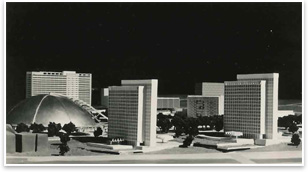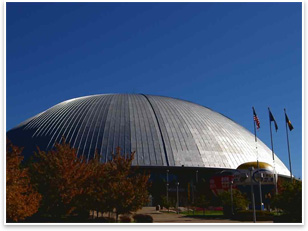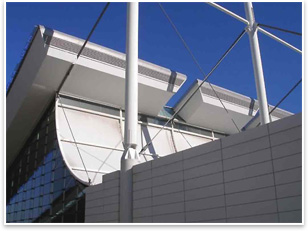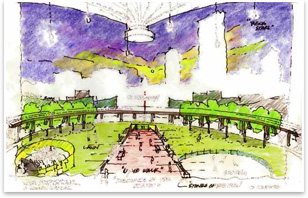The
Pittsburgh Civic Arena: Memory and Renewal
by Rob Pfaffmann, AIA
Pfaffmann and Associates
 Summary: This
article contains excerpts from an abstract prepared for the 2008
DOCOMOMO conference, “The Challenge of Change,” adapted
for this special edition of AIArchitect to explore what we have truly
learned from our past. It challenges the current belief that Modern
planning and design interventions are obsolete through a proposal
to reuse the Pittsburgh Civic Arena as an anchor for a new urban
plan that interweaves the multiple historic layers with Modern planning
themes. Summary: This
article contains excerpts from an abstract prepared for the 2008
DOCOMOMO conference, “The Challenge of Change,” adapted
for this special edition of AIArchitect to explore what we have truly
learned from our past. It challenges the current belief that Modern
planning and design interventions are obsolete through a proposal
to reuse the Pittsburgh Civic Arena as an anchor for a new urban
plan that interweaves the multiple historic layers with Modern planning
themes.
 Urban renewal in Pittsburgh: success and failure Urban renewal in Pittsburgh: success and failure
The history of urban renewal in Pittsburgh is a story of success
and failure. Pittsburgh’s environmental reform movement is
most often cited, but less known are the sometimes innovative but
often failed efforts to redesign large areas of the city following
Modern design principles. Much of the legal basis for urban renewal
laws (eminent domain) in America was created in Pittsburgh during
the 1940s and ’50s.
A debate is now taking place in planning and architecture professions
in the aftermath of Hurricane Katrina in New Orleans in 2005. Pittsburgh,
the city experiencing the second greatest population loss outside
of New Orleans, also is challenged with the reconstruction of large
areas of the urban fabric devastated by urban renewal and economic
decline. Whether it is Pittsburgh’s Point State Park/Gateway
Center, East Liberty, or the Civic Arena/Lower Hill, each project
is a product of its time and prevailing view about urban design, architecture,
and economic renewal. The nature and extent of civic discourse and
examination of the failure to fully execute proposed plans is an
important component of these questions.
 The profession/policies of American historic preservation have identified
the need to stand back from current popular views of a design or
style (the “50-year rule”). At the turn of the 19th century,
many believed that the “excesses” of the Victorian era
were not worth saving. That attitude translated into wholesale demolitions
of important fabric of our cities. Until Jane Jacobs and Robert Moses
clashed in the 1960s, many only saw these issues as ones of style,
not as a foundation for healthy city development. Pittsburgh, because
of its environmental and economic troubles, became a place where
Modern design principles were used extensively in the urban renewal
process. The profession/policies of American historic preservation have identified
the need to stand back from current popular views of a design or
style (the “50-year rule”). At the turn of the 19th century,
many believed that the “excesses” of the Victorian era
were not worth saving. That attitude translated into wholesale demolitions
of important fabric of our cities. Until Jane Jacobs and Robert Moses
clashed in the 1960s, many only saw these issues as ones of style,
not as a foundation for healthy city development. Pittsburgh, because
of its environmental and economic troubles, became a place where
Modern design principles were used extensively in the urban renewal
process.
What does it mean to “undo the past”?
Today, across Pittsburgh, major projects that propose to “undo
the damage of urban renewal” are well under way. As Pittsburgh’s
political leadership undertakes this effort, current urban design
and planning trends (New Urbanism, Contextualism, etc.) are assumed
to be preferable to the past Modern schools of thought regarding
planning and design.
Pittsburgh’s Hill District, which is one of the nation’s
most important historic African-American communities, was extensively
destroyed for the Civic Arena, a project led by Edgar Kaufmann (Fallingwater’s
owner) and designed by architects James A. Mitchell and Dahlen K.
Ritchey. We must explore what we have truly learned from our past
and challenge the current belief that Modern planning and design
interventions are obsolete through a proposal to reuse the Civic
Arena as an anchor for a new urban plan that interweaves the multiple
historic layers with Modern planning themes.
 Taking a cue from Jacobs: “Cultural or civic centers, can
probably in a few cases employ ground replanning tactics to reweave
them back into the city fabric. The most prominent cases are centers
located on the edges of downtowns . . . One side of Pittsburgh’s
new civic center, at least, might be rewoven into the downtown, from
which it is now buffered,” she wrote in The
Death & Life
of Great American Cities in 1962. Taking a cue from Jacobs: “Cultural or civic centers, can
probably in a few cases employ ground replanning tactics to reweave
them back into the city fabric. The most prominent cases are centers
located on the edges of downtowns . . . One side of Pittsburgh’s
new civic center, at least, might be rewoven into the downtown, from
which it is now buffered,” she wrote in The
Death & Life
of Great American Cities in 1962.
Brainstorming: ideas to build upon
- Reinvent Mellon Arena as an innovative community anchor.
- Take a holistic approach to the entire Hill: a supermarket,
more affordable housing over a parking deck buried below an expansion
of Crawford Square with loft houses, and the restoration of the
New Granada Theater and the Crawford Grill.
- Make Wylie Avenue a key pedestrian connection to downtown,
where you actually walk right through the arena civic space, learning
about old and new Wiley Avenue as you go. The path would continue
through a new park surrounded by state-of-the-art, mixed-use buildings
with large floor plates.
- Rebuild Fifth Avenue into a strong, pedestrian- and transit-oriented
place that emphasizes historic façades and high-quality
Modern infill urban construction for the new economy, emphasizing
small businesses and relationships to higher education.
- Make sustainable design, innovative urban design, and historic
preservation the anchors, to compete for people wanting authentic,
different places to live, work, and play. Divert storm-water runoff,
build geothermal fields, create new public open space, and inspire
new park-front property development.
This is only a set of ideas. You the reader must transform it, mess
with it, and make it truly a product of community collaboration! |





